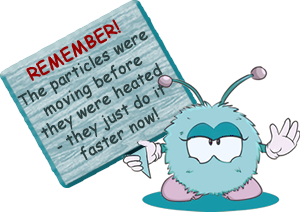    |
||||

Convection |
||||
|
Convection is the transfer of heat throughout a fluid by the movement of the particles that make up that fluid. A fluid is anything that can flow - liquid or gas. Take a look at BOTH of these vid clips... the first one is on density, but that is very important if you are to understand convection! Many people explain convection by saying that 'heat rises'. Heat doesn't always rise.... it travels from hot to cold areas. We think that it does because of our experience of convection. Heated fluids rise! .... we experience this in our everyday lives and therefore the generalisation that heat always rises gets repeated. Liquid
GasWhen part of a gas is heated it's molecules in that region become excited. That means that the gas molecules in the region of the heat source move more rapidly creating pressure on the surrounding cooler gas. This makes more average space between particles near to the heat source than further away from it. So the gas near to the heat source has less density than the surrounding gas which means that it floats up in surrounding cooler denser fluid. The cooler fluid then replaces the warm rising fluid and a current is set up (see illustration above). So, where gravity is a factor, such as here on earth, the natural fluid motion moves the heated, less dense fluid up and the cooler, more compact fluid down. This is why heating vents are located along the floor, while air-conditioning outlets are located near the ceiling. Convection is NOT POSSIBLE in a solid because the particles in a solid cannot move relative to one another. It is the principal mode of heat transfer within fluids. The 'Chimney' Demonstration illustrates convection currents in gases.
Remember to always mention how it is difference in density that makes warm fluid rise and that cool fluid moves in to replace the displaced fluid - and to mention the term 'convection current' when you explain what happens.... |
||||
 |
||||


 When a liquid is heated
it's molecules become exited and start moving
When a liquid is heated
it's molecules become exited and start moving 
